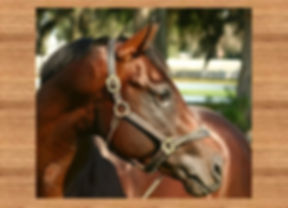
Horse Owner Information
Do you have a horse just diagnosed with EPM or has had EPM and has relapsed? Join us in our path to licensing an approved therapy by talking to your veterinarian, fill out the owner information sheet, look at the study entrance requirements and sign up for our clinical trials! Your participation ensures that more treatments will enter the drug pipeline. Be sure and sign up to get notified when we post a new blog. The blogs will keep you in touch with our new research.
Decoquinate is not approved for use in horses. There are no published safety studies using decoquinate in horses.Treating horses with decoquinate is an off label use and must be supervised by a veterinarian. Treating more than 1 month may be detremental and has been linked with endotoxemia.
If you don't know which tests to select, contact us. We will consult with your veterinarian and suggest a path forward. You can use the "Let's Chat!" button on this page, email us, or call us to schedule a zoom meeting.
Equine protozoal myeloencephalitis is a rare disease! What does rare disease mean?
We say upfront that equine protozoal myeloencephalitis (EPM) and polyneuritis equi (PNE) are diseases that require specialized knowledge and expertise. Many lay suggestions on the web will ultimately make your horse unusable or unsalvageable. Some combinations of drugs will cause PNE! Be sure to consult your veterinarian before combining medications.
A horse owner often knows when their horse is under the weather, before neuromuscular disease is advanced. Our paper describing the Early Signs of Equine Protozoal Myeloencephalitis can help you recognize the earliest warning signs of disease. The paper is based on experimental infections using S. neurona in the Trojan Horse model.
Sometimes signs aren't so vague, the horse can be severely wobbly (ataxic) or even so bad that they are unable to get up. And at other times, the horse has been suffering with EPM so long that a dull, distracted demeanor is accepted as "normal".
A therapeutic plan should include multiple exams following treatment and time-appropriate serum analysis.
We use specific surface proteins, called surface antigens (SAG's) taken from the S. neurona parasite to test your horse's serum. The SAG's are very reactive and cause the horse to make antibodies when S. neurona is present. We report the the serotype, there are three different serotypes that can infect your horse, often all three will be present if three strains are in the environment. Some proteins are “common” to all coccidia and some are specific to one of three individual serotypes of S. neurona. Non-specific tests, (IFAT, SAG 2, 4/3), measure the common proteins found on all protozoa, we don't find those useful. The serotype of S. neurona is determined by detecting antibodies to SAG 1, 5, or 6. The serotype is the level a horse can detect, genetic differences are left to the molecular biologists.
Our S. fayeri test measures the amount of antitoxin found in your horse's serum. Antitoxin is the immune reaction to disease causing proteins produced by pathogenic S. fayeri which infect horses. Most horses have S. fayeri muscle cysts (EMS) but only 6% of S. fayeri strains produce disease-causing toxins. That makes S. fayeri an unusual cause of clinical signs but it should be considered.
A common factor in diseases caused by S. neurona and S. fayeri, (infection caused by either of these organisms is sarcocystosis) and the clinical signs are due to inflammation. Inflammation is measured by a serum CRP test. Horses that respond to anti-protozoal treatment without a reduction in CRP values eventually relapse. Our research shows the higher the CRP value, the more likely the horse is to have polyneuritis. CRP may be elevated due to infections other than Sarcocystis.
1-three conditions are associated with sarcocystosis: S. neurona, S. fayeri toxicosis, and polyneuritis; polyneuritis can be non-demyelinating or demyelinating;
2-the neurona-associated sarcocystosis group describes only 8% of chronic, relapsing/remitting disease seen in the horse population;
3-autoimmune polyneuritis, a disease found in horses with antibodies against the myelin P2 protein is detected in 43% of horses with relapsing disease;
4-S. fayeri antitoxin is detected in 49% of horses with chronic neuromuscular disease and 6% of horses with S. fayeri cysts in muscles;
5-each of the three conditions will require different treatment, although the conditions can overlap.
The most crucial aspect of disease management is clinical exam by your veterinarian. The veterinarian has the most up to date diagnostic and treatment protocols that enable forming a treatment plan. Testing the serum for CRP levels can let the veterinarian know if the inflammation is controlled after treatment. Another useful test is neurofilament light, these tests change quickly with proper treatment.

Click to stop and start

